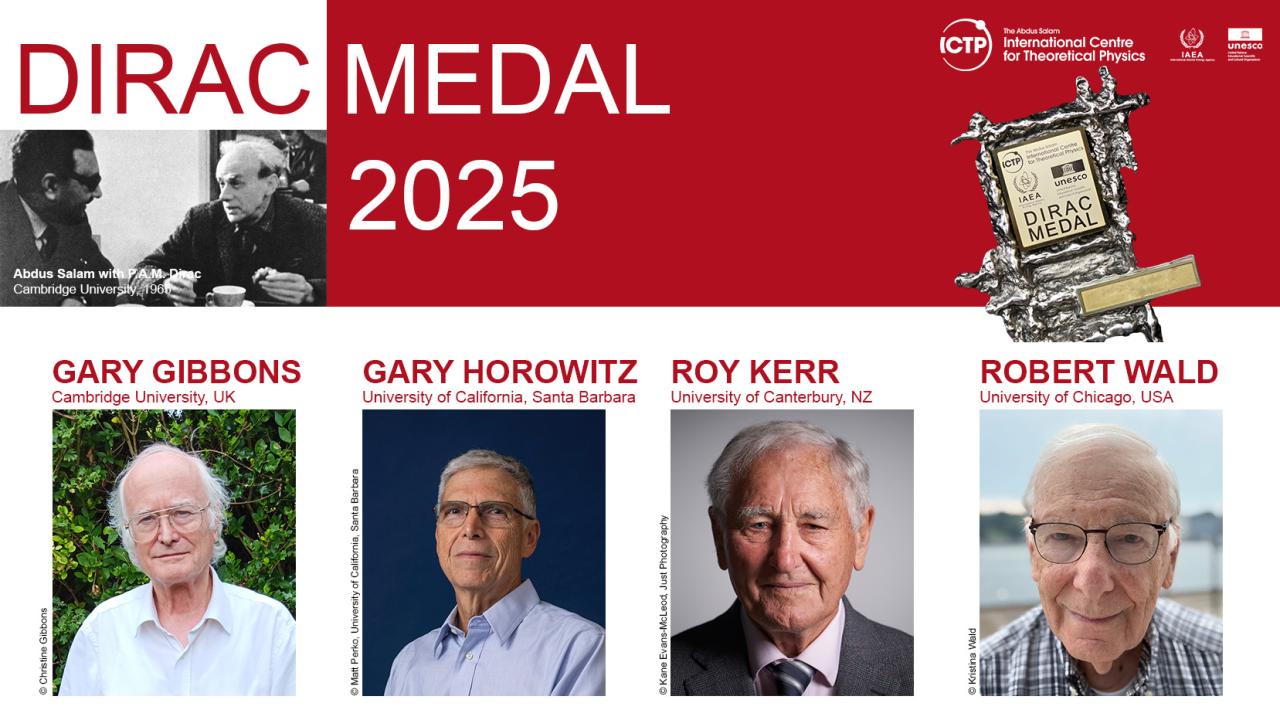
They were among the first to use black holes as a testing ground for innovative theories on general relativity, quantum gravity and string theory. Three different approaches, one common goal: to understand gravity and the deep structure of space-time. Through their research, they have transformed objects long considered abstract and inaccessible into some of the most powerful tools for probing the secrets of the universe.
In recognition of these contributions, ICTP awards the 2025 Dirac Medal to four theoretical physicists who have redefined our understanding of gravity:
- Gary Gibbons, Cambridge University, UK
- Gary Horowitz, University of California Santa Barbara, USA
- Roy Kerr, University of Canterbury, New Zealand
- Robert Wald, University of Chicago, USA
The award recognizes “their landmark contributions which have significantly shaped the study of general relativity across many generations. Their work collectively has laid the conceptual and technical foundations of our understanding of gravity, at both the classical and quantum levels.”
The work of the 2025 Dirac Medallists gives a wide perspective on gravity and has impacted physicists’ efforts to understand the weakest of all fundamental forces and formulate its quantum description.
The winners’ scientific endeavours address a broad range of problems and are united by their interest in black holes. Long considered a mere theoretical hypothesis, these astronomical objects – characterised by a gravitational pull so strong that even light cannot escape – are now known to populate our universe. They also exemplify how purely theoretical explorations can sometimes lead to remarkable insights about the physical world, even in the absence of much guidance from direct observation. This year’s medallists mathematical work in classical general relativity now informs a multitude of observations in astrophysics, black hole physics, or gravitational waves. At the same time, it has provided the foundations for further explorations of the quantum aspects of black holes such as the laws of black hole thermodynamics or holography.
“I warmly congratulate the 2025 Dirac Medallists, whose groundbreaking work spans a wide range of topics in classical and quantum gravity and has greatly influenced generations of physicists, including myself," said ICTP Director Atish Dabholkar, adding, "This Dirac Medal stands as a tribute to the power of our physical theories and the richness of the underlying mathematical structures which enable us to venture with some confidence into the uncharted territory in our efforts to uncover the consistent physical laws of nature.”
The scientific achievements of the four winners are summarised below:
Gary Gibbons
Gary Gibbons has made foundational contributions across general relativity, quantum gravity, and mathematical physics. One of his key contributions, in collaboration with Hawking, was the development of the Euclidean path integral formulation of quantum gravity. This approach, based on a semiclassical approximation to a path integral over geometries, led to many fundamental insights and remains an indispensable tool. For example, it led to the study of gravitational instantons and significantly advanced our understanding of the thermodynamic properties of black hole and cosmological horizons. A technical offshoot of this work was the introduction of the Gibbons–Hawking–York boundary term, which is essential to have a well-defined variational principle for the Einstein-Hilbert action on manifolds with boundaries. His seminal work on higher-dimensional black holes and supersymmetric solutions laid key foundations for developments in string theory and holography.
Gary Horowitz
Gary Horowitz has played a central role in transforming string theory into a framework for describing spacetime geometry. His 1984 collaboration with Candelas, Strominger, and Witten on Calabi–Yau compactifications was a foundational contribution, providing the first realistic path from ten-dimensional superstring theory to four-dimensional physics with 𝑁=1 supersymmetry. This breakthrough also marked a turning point in which string theory began to fully engage with geometry and gravity. His collaboration with Strominger on black branes established the gravitational interpretation of D-branes, paving the way to the AdS/CFT correspondence. Later, his collaborations with Hartnoll and Herzog produced holographic models of superconductivity, helping to establish the “AdS/CMT correspondence” as an active area of research.
Roy Kerr
Roy Kerr’s discovery of the exact solution of Einstein’s equations describing a rotating black hole is certainly one of the great advances in general relativity. The Kerr metric, introduced in 1963, generalized the Schwarzschild solution to the physically relevant case of rotating black holes. It has since become a cornerstone of both gravitational theory and modern astrophysics. The Kerr solution has had a profound and lasting influence on both classical and quantum aspects of gravity. It revealed an array of new phenomena such as frame dragging, ergoregions, and superradiance, that would become essential to both theoretical and observational developments. This metric underpins our current understanding of astrophysical black holes and forms the basis for interpreting black hole mergers observed by the LIGO/Virgo/KAGRA collaboration and the images produced by the Event Horizon Telescope. Further, this solution has informed decades of work on the uniqueness, stability, and even thermodynamics of black holes. For example, the Kerr solution played a key role in the discovery of the four laws of black hole mechanics by Bardeen, Carter and Hawking.
Robert Wald
Robert Wald has made a range of foundational contributions to the formal structure of gravitational theory, marked by their mathematical rigor and physical importance. One of his most significant results is a prescription of horizon entropy in general diffeomorphism-invariant theories of gravity. Developed further with his student Iyer, this formalism expresses horizon entropy as a Noether charge associated with diffeomorphism invariance. While central to our modern understanding of black hole thermodynamics, it also laid the foundation for extensions of holographic entanglement entropy to general gravitational theories and its applications. His other contributions in classical general relativity include his work on black hole stability, energy theorems, and cosmic censorship. His formulation of quantum field theory in curved spacetime provides a conceptual and technical framework for understanding phenomena such as Hawking radiation, the Unruh effect, and the renormalization of stress-energy tensors in curved backgrounds.
















